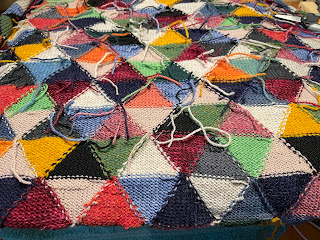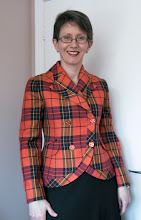A friend told me she couldn't find the post on my blog about an epic machine knitting project that I completed on Christmas day in 2021. Nor could I, because it didn't exist! Poor, poor neglected blog.
To recap, one day in late summer of 2021 I got the totally idiotic idea to knit my husband a vest using left over bits of sock yarn in my (ahem) extensive stash. In intarsia. Based on a hand knitting pattern by Kaffe Fassett.
Here is the photo from the original pattern (Ravelry link), which is in a book I happen to own.Of course, all the yarn that was originally recommended is long since discontinued. However, this is the type of project that practically begs you to use whatever you have on hand.
I had so much miscellaneous fingering weight yarn, even including some orphan discontinued Rowan skeins sourced by my husband at thrift shops. How fitting to include them in my project.
Husband and I went stash diving and came up with a palette that worked.
I ended up using most/all of these yarns in the finished vest.
The pattern looks complicated but breaks down into understandable chunks.
If you squint at the pattern photo, it resolves into a quilt-ish looking pattern of hexagons against a neutral background. The hexagons are comprised of 6 triangles each and the background is also triangles. Each triangle is 16 stitches wide at its horizontal side (base or top, depending on whether it is point up or point down) and 16 rows high.
I decided that each hexagon needed to have two dark triangles, two warm coloured triangles, and two cool coloured triangles. I had two different neutrals (a warmer and a cooler beige). Other than that, my only colour rule was not to repeat the same colour in the same orientation too closely together. It had to look kind of random, but kind of ordered at the same time.
This is what intarsia knitting looks like while on the machine.
I used "butterflies" of yarn wound on my left hand - a butterfly wrapped about 20 times was more than enough for one triangle. Plus, the dangling butterfly was about the right amount of weight on the yarn to keep it from jumping off the needles during knitting. The clothes pins are holding down the end of the yarn at the very beginning of each triangle; the butterfly hangs from the last knitted stitch in each colour. The other things hanging off the knitting are claw weights, which help keep the entire knitted piece on the machine.
And here's a video on how to knit intarsia on a machine. It's not rocket science, but it does take concentration. I started with the fronts on the theory that they would ease me into the process (half the width, half the number of different colours in a single row). The photo above is of the back. Even after knitting both fronts without serious incident (that I now recall), I found I could only knit two rows of triangles (total of 32 intarsia rows) at a time before needing a break.
Long story short, Ravelry tells me that I started this project on August 29 and finished it on December 25, 2021.
Once the ends are woven in, the back is almost as neat as the front.
With a pipe. Because male models in knitting patterns are often holding a pipe, if not a gun of some kind.










Wow, that is some vest and quite a bit of work to keep all those little butterfly skeins in line. I like the comment "It has pockets!" Everything needs pockets!
ReplyDeleteKay! It's beautiful! "It's not rocket science, but it does take concentration". What a wonderful job you did. And used up some of the stash, to boot. A win-win. And shout out to Theresa! Nice to see former SG members still sewing and knitting! Sewsy
ReplyDeleteBrava! to the tenth power. Stunning. Perfection. Lucky husband. His shirt is the perfect colour to be worn with this work of art. He looks model handsome with his pipe.
ReplyDeleteJust absolutely gorgeous! Thanks for sharing this.
ReplyDeleteWonderful vest. I've never dived into machine knitting, looks quite complicated to me.
ReplyDeleteGorgeous! What a lucky husband!
ReplyDeleteFantastic!
ReplyDeleteI am so glad I found your blog and so glad you are still writing a blog. I had been in Insta land for awhile and so many blogs had disappeared. I am happily reading backwards till I get to when I had read it in the past. Love your outfits and the knitting is terrific!
ReplyDeleteBeautiful vest. You have great talent 👏 Warm greetings from Montreal, Canada ❤️ 😊 🇨🇦
ReplyDeleteThat is amazing Kay . Well done . I am glad it was a pipe and not a gun . Way to South of the border for these troubled times. Marianne in Australia
ReplyDeleteLove it!
ReplyDeleteAnd you must be so pleased... looking at the knitting strands, all clipped together like that. It looks very complicated. Makes me think of Joseph and his coat of many colours...